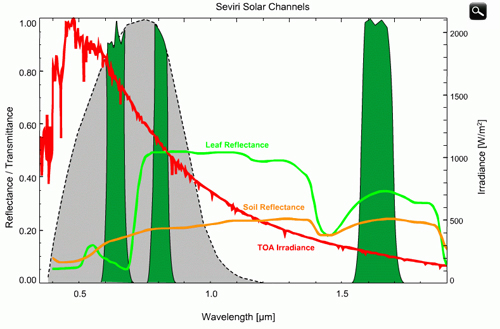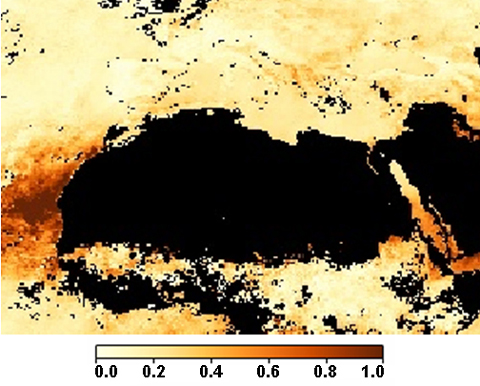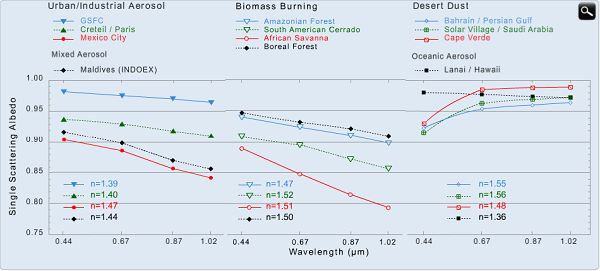Aerosol Detection
First you should be aware that the channels best suited for aerosol detection are those with wavelengths smaller than 0.7 μm (700 nm), because there is less reflectance from the surface (forest, types of soil, ...) to interfere in the detection. You can check this property in Figure 5.22, which shows the difference of soil reflectance and (mainly) leaf reflectance between the two SEVIRI visible narrow bands (0.6 μm and 0.8 μm).

The aerosol optical thickness (or aerosol optical depth) is a measure of the concentration of aerosols in the atmosphere and can be estimated through remote sensing. The product is obtained with the MODIS sensor on board the AQUA and TERRA satellites. It is available on 10 km boxes for seven wavelengths between 0.47 and 2.13 μm over ocean and three wavelengths (0.47 μm, 0.66 μm and 2.13 μm) over land. A joint land and ocean product is estimated for 0.55 μm as this wavelength is usually used in climate modelling (Remer et al, 2005).
You can see an example in Figure 5.23 in which several local maxima are depicted for the period between 1 July and 1 August 2007.

In fact, the absorption of radiation by biomass burning aerosols is higher than for other aerosols, such as desert dust or oceanic aerosols. This fact is confirmed in Figure 5.24, where single scattering albedo (ratio of scattering to scattering plus absorption) is shown for different kinds of aerosol; urban/industrial, biomass burning, desert dust and oceanic aerosol. The lower the single scattering albedo, the higher the absorption!

You should also keep in mind that for biomass burning, approximately 90% of released carbon is oxidized to CO2 or CO and less than about 5% of the carbon is released as particulate matter. Furthermore, smoke particles (which are composed of both organic carbon [~50-60%] and black carbon [~5-10%]) are effective cloud condensation nuclei, therefore influencing cloud microphysics and even precipitation processes (Reid et al, 2005).
However, the relationship between aerosols and clouds (aerosol-cloud interaction) is not so straightforward as you may think. Studies for Brazilian forests show that a greater aerosol load leads to higher cloud droplet concentrations (or cloud fractions), but only up to a point. In fact, above a certain threshold, increasing aerosol load does not necessarily lead to more cloudiness (Feingold et al, 2001, Xue et al, 2008). For these cases, other properties may play a role, namely the size of the aerosol particles and the hygroscopicity (capacity of the aerosol to react with air moisture content), but this topic is still under investigation by the scientific community.
So, when you see smoke on an image using bands from the visible part of the spectrum, you may expect to also see water clouds after some time, including the so-called pyrocumulus we already had the opportunity to discuss earlier in the module.